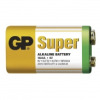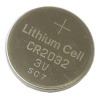batteries
Table of Contents
| Image | Type | Voltage | Typical Capacity | Cutoff Voltage |
|---|---|---|---|---|
 | 6LR61, 6LF22 | 9V | 500mAh | 4.8V |
 | CR2032 | 3V | 225mAh | 2V |
Discharge
Lion / LiPol can be deeply discharged, but must me charged separately (each cell) - affect lifespan little NiMH / NiCD this won't matter it can be flat.
Charging
| CC | Constant Current | This design is usually used for nickel-cadmium and nickel-metal hydride cells |
| CV | Constant Voltage | Used for charging Lithium and some other batteries which may be vulnerable to damage if the upper voltage limit is exceeded |
| -dV (−ΔU) | Derivative Voltage (Change in voltage) | This is the most popular method for rapid charging for NiCD |
| dt | Derivative Time (Change in time) | |
| Pulsed charge | This enables the chemical reaction to keep pace with the rate of inputting the electrical energy. | |
| Negative Pulse Charging | It applies a very short discharge pulse, typically 2 to 3 times the charging current for 5 milliseconds, during the charging rest period to depolarise the cell. |
QA:
Can I charge LiPol with LiOn charger? Yes, but be careful.
Longer lifespan? Use battery/cell between 50-75%C (Lion-Lipol) 70-95%C (NiMH)
Primary
Alkaline
Labeled as: Alkaline
2x 11x better than Zinc-Chloride/Carbon
| Time durability | 5–10 years |
| Nominal cell voltage | 1.5 V |
| Self-discharge rate | <0.3%/month |
Zinc–Carbon
Labeled as: GENERAL PURPOSE/SUPER CELL
Zinc–Chloride
Labeled as: SUPER/HEAVY DUTY
Secondary
NiCD
Memory effect
| Cycle durability | ~2,000 cycles |
| Nominal cell voltage | 1.2 V |
NiMH
Memory effect
| Cycle durability | ~700 cycles |
| Nominal cell voltage | 1.2 V |
* Recommended - Eneloop, Panasonic, Tesco Green, GP ReCyko+
Li-Ion
No memory effect
| Cycle durability | ~700 cycles |
| Nominal cell voltage | 3.7 V |
| Self-discharge rate | <5%/month |
| Max voltage | 4.2V |
Li-Pol
No memory effect
| Cycle durability | <2000 cycles |
| Nominal cell voltage | 3.7 V |
| Cut-off voltage | 2.7 V |
batteries.txt · Last modified: 2018/02/10 12:16 by Jan Forman